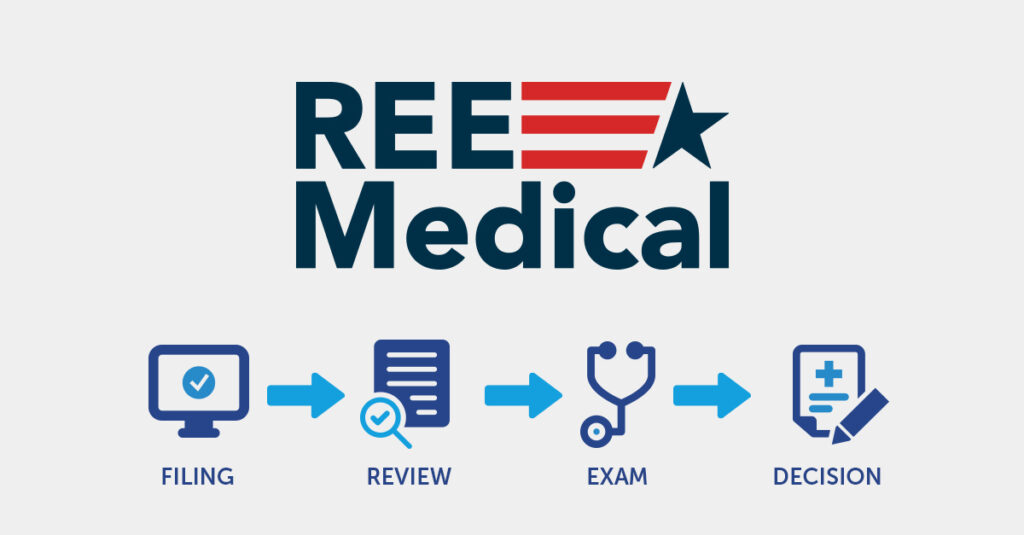Migraine headaches can be extremely debilitating, often disrupting daily activities and affecting overall quality of life. For veterans, migraines may develop as a result of service-related factors such as stress, injury, or environmental exposure. The Department of Veterans Affairs (VA) evaluates migraine-related disability under Diagnostic Code 8100, which outlines how frequency, duration, and severity determine compensation levels.
This guide explains how the VA applies Diagnostic Code 8100, the types of medical evidence typically reviewed (such as Disability Benefits Questionnaires (DBQs), symptom diaries, and lay statements), and how service connection can be medically established—whether directly, secondarily, or presumptively. It also summarizes how Total Disability based on Individual Unemployability (TDIU) and appeal options may apply in cases where migraines significantly affect employability or quality of life.
REE Medical works with independent, licensed healthcare providers who develop comprehensive medical documentation, such as DBQs, that Veterans may choose to submit as part of their VA disability evaluations. REE Medical does not prepare, present, or submit claims and does not offer legal or representational services
TL;DR
- Rating Criteria: Migraines are evaluated under Diagnostic Code 8100 at 0%, 10%, 30%, or 50%, depending on symptom frequency and impact.
- Service Connection: The VA considers whether migraines began during, were aggravated by, or are secondary to service-related conditions.
- Medical Evidence: DBQs, migraine logs, and medical opinions allow the VA to assess severity and functional limitations.
- Functional Impact: The VA reviews the frequency of “prostrating attacks” and their effect on occupational and social functioning.
- TDIU Consideration: Veterans whose migraine symptoms prevent substantially gainful employment may be evaluated for TDIU benefits.
- Appeal Options: Veterans can pursue review options under the Appeals Modernization Act (AMA) if a claim is denied or underrated.
What Is the VA Disability Rating for Migraines and How Is It Determined?

The Department of Veterans Affairs (VA) assigns disability ratings for migraine headaches under Diagnostic Code 8100 in the Schedule for Rating Disabilities. Evaluations are based on the frequency, severity, and duration of prostrating attacks, as well as the degree to which these attacks contribute to economic inadaptability. The VA reviews medical evidence, such as treatment records and clinician reports, to determine the appropriate percentage rating.
What Is VA Diagnostic Code 8100 for Migraines?
Diagnostic Code 8100 outlines the specific criteria used by the VA to evaluate migraine-related disabilities. The code distinguishes between mild, moderate, and severe migraine patterns by considering clinical features such as nausea, vomiting, photophobia (light sensitivity), and visual disturbances or auras. These symptoms allow the VA to assess the overall functional impact of migraine attacks and assign a rating that reflects the documented level of impairment.
How Does the VA Rate Migraines: 0%, 10%, 30%, and 50% Criteria?
The VA gives ratings of 0%, 10%, 30%, or 50% for migraines based on how often and how severe your attacks are. They want to see how much these attacks stop you from doing things.
Here’s a breakdown of how symptom severity can lead to a disability percentage:
| Severity Level | Criteria Description | VA Rating |
| No current impact | Headaches are present but don’t really affect your ability to earn a living. | 0% |
| Mild interference | You have attacks that make you lie down (prostrating) about once or twice a month. | 10% |
| Moderate interruption | You have prostrating attacks two to four times a month, and they cause some loss of activity. | 30% |
| Severe impairment | You have prostrating attacks weekly or more often, and they make it hard to work. | 50% |
What Are Prostrating Attacks and Economic Inadaptability in VA Ratings?
Under Diagnostic Code 8100, the Department of Veterans Affairs (VA) evaluates migraines based on both symptom severity and their impact on a person’s ability to function. A prostrating attack refers to a migraine episode so severe that it requires rest in a dark, quiet environment due to pain, nausea, or sensitivity to light and sound.
Economic inadaptability describes a level of migraine-related impairment that substantially interferes with the ability to maintain gainful employment. These definitions allow the VA to determine how severely migraines affect occupational and daily functioning, which in turn informs the assigned disability rating.
How Do Frequency and Severity Affect Your Migraine Rating?
The VA considers both the frequency and severity of migraine episodes when assigning evaluations. Factors typically reviewed include:
- The number of prostrating attacks occurring within a given month.
- The degree to which migraine symptoms limit daily activities or occupational tasks.
- The typical duration of incapacitating episodes.
- The presence of associated symptoms such as nausea, vomiting, or sensitivity to light.
Medical records, clinician observations, and documented symptom histories allow the VA to objectively determine how frequently and severe migraines occur. This information allows for a consistent evaluation under the VA’s established criteria.
How Can Veterans Prove Service Connection for Migraines?

To assign a disability evaluation for migraines, the Department of Veterans Affairs (VA) must determine that the condition is linked to military service. The most common form of service connection is direct service connection, which is established when evidence shows that migraine symptoms began during service or were documented in service treatment records. Consistent medical evidence showing continued headaches after separation from service can further support this connection.
Service Connection and Evidence Considerations for Migraine Evaluations
Migraines may also be recognized as secondary to another service-connected condition. Research and clinical findings indicate that post-traumatic stress disorder (PTSD), traumatic brain injury (TBI), and tinnitus can contribute to or worsen migraine symptoms.
While migraines are not designated as a presumptive condition, the VA considers the continuity of symptoms—such as headache patterns emerging soon after service and persisting over time—as potentially relevant evidence.
When reviewing a claim, the VA typically evaluates several forms of medical documentation, including:
- Treatment records showing diagnosis and ongoing management.
- Medical opinions explain how migraine symptoms relate to service.
- Disability Benefits Questionnaires (DBQs) detailing frequency and severity.
- Lay or “buddy” statements describing the real-world effects of migraine attacks.
Together, these sources provide a comprehensive view of how the condition developed and how it affects daily functioning.
What Is Direct Service Connection for Migraines?
A direct service connection is established when clinical and service documentation show that migraine symptoms were present during or immediately following active duty. Evidence may include references to headaches or migraine-like symptoms in service treatment records, followed by continuous post-service medical documentation demonstrating persistence or progression of the condition.
Can Migraines Be a Secondary VA Disability?
Migraines may be evaluated as secondary to another service-connected condition when medical evidence indicates a causal or aggravating relationship.
For example, chronic stress or sleep disruption associated with PTSD, auditory strain from tinnitus, or neurological complications from TBI may contribute to migraine onset or worsening. In these cases, medical opinions that explain the physiological link between the conditions are key pieces of evidence for VA review.
What Are the Criteria for Presumptive Service Connection for Migraines?
At present, migraines are not classified as a presumptive condition under VA regulations. However, if medical documentation shows that chronic headaches began within one year of discharge or have persisted continuously since service, this information may be considered when assessing potential service connection. A clinician’s medical opinion can aid in clarifying whether the timing and pattern of symptoms align with known service-related factors.
What Evidence Does the VA Review When Evaluating Migraine Claim?
When assessing a migraine-related disability, the Department of Veterans Affairs (VA) relies on multiple sources of documentation to determine both medical severity and potential service connection. This includes official medical forms, clinical opinions, and personal accounts describing how migraines affect daily functioning. Collectively, this evidence allows the VA to form an objective picture of symptom patterns and their impact on occupational and social life.
Why Is the Migraine Disability Benefits Questionnaire (DBQ) Important?
The Headaches (Including Migraine) Disability Benefits Questionnaire (DBQ) is a standardized medical form used by licensed healthcare professionals to document the frequency, duration, and severity of migraine attacks. The form also records associated symptoms—such as nausea, sensitivity to light or sound, and the need for rest during attacks.
Because the DBQ uses uniform language that aligns with the VA’s rating schedule, it allows the VA to evaluate migraine-related impairment consistently and accurately.
What Role Do Lay Statements and Buddy Statements Play?
Lay statements (from the veteran) and buddy statements (from family members, friends, or coworkers) provide firsthand accounts of how migraines manifest and interfere with daily life. These statements can complement medical records by describing observable symptoms, frequency of episodes, and long-term effects that may not always appear in clinical documentation. The VA considers these accounts as part of the overall evidentiary record.
How Do Migraine Diaries Contribute to VA Evaluations?
A migraine diary can provide valuable longitudinal data on the timing, frequency, and severity of migraine attacks. These records often include dates, duration of episodes, associated symptoms, and any limitations on work or daily activities.
When reviewed alongside medical documentation, this information allows clinicians and the VA to understand the functional impact of the condition and ensures that evaluations are based on consistent, detailed evidence.
How Can You Maximize Your VA Migraine Benefits and Ratings?

Veterans who experience worsening migraine symptoms after receiving an initial rating can request that the Department of Veterans Affairs (VA) review their evaluation. The VA bases updated ratings on new or https://reemedical.com/what-determines-your-va-rating/ that reflects the current severity and frequency of migraine attacks.
When Does the VA Reassess Migraine Ratings?
A reassessment may occur when medical evidence indicates that migraines have increased in frequency or intensity since the prior decision. Updated records—such as physician notes, completed Disability Benefits Questionnaires (DBQs), or recent diagnostic results—allows the VA to determine whether a higher evaluation is warranted under Diagnostic Code 8100.
Additional lay statements, symptom logs, or clinician observations that describe functional impact may also be considered as part of the review process.
What Is Total Disability Based on Individual Unemployability (TDIU) in Migraine Cases?
Total Disability Based on Individual Unemployability (TDIU) is a VA benefit that compensates veterans at the 100% disability rate if service-connected conditions prevent them from maintaining substantially gainful employment.
For migraine-related cases, the VA reviews both the severity of migraine attacks and their documented effect on occupational capacity. Veterans may be considered for TDIU if medical and vocational evidence demonstrates that migraine-related symptoms substantially interfere with employability, even if the overall combined rating is less than 100%.
How Does the VA Review Appeals for Migraine Evaluations?
Veterans who disagree with an initial decision have the right to request a review under the Appeals Modernization Act (AMA). The available options include a Supplemental Claim (submission of new evidence), a Higher-Level Review (review by a senior adjudicator), or an appeal to the Board of Veterans’ Appeals (BVA).
During this process, the VA re-examines the record, considering any updated medical documentation, DBQs, or symptom diaries. Decision letters explain the reasons for approval or denial, outlining what evidence was used in the determination.
What Are Common Questions About VA Migraine Ratings?
Below are responses to some frequently asked questions about how the Department of Veterans Affairs (VA) evaluates migraine-related disabilities.
What Is the Highest VA Rating for Migraines?
Under Diagnostic Code 8100, the highest schedular evaluation for migraine headaches is 50 percent. This level is reserved for cases involving very frequent, completely prostrating, and prolonged attacks that cause severe economic inadaptability—that is, the inability to maintain substantially gainful employment due to the condition’s intensity and frequency.
How Does the VA Determine a 50 Percent Migraine Evaluation?
The VA reviews medical documentation describing the frequency, duration, and severity of migraine attacks, along with their impact on daily and occupational functioning. A Disability Benefits Questionnaire (DBQ) completed by a qualified clinician, supported by treatment records and clinical opinions, provides objective data for this assessment.
What Evidence Does the VA Consider for Migraine Evaluations?
When evaluating a migraine-related claim, the VA typically reviews:
- A confirmed medical diagnosis of migraine headaches.
- A DBQ describing symptom patterns and frequency.
- Medical opinions discussing any relationship to service or other service-connected conditions.
- Lay statements or symptom diaries documenting real-world functional impact.
Together, these records allow the VA to determine how the condition aligns with the criteria in Diagnostic Code 8100.
Can Migraines Be Secondary to Other Service-Connected Conditions?
Migraines may be evaluated as secondary when medical evidence shows they are caused or aggravated by another service-connected condition such as post-traumatic stress disorder (PTSD), tinnitus, or traumatic brain injury (TBI). A clinician’s opinion explaining the physiological link between conditions is typically required for review.
How Does the VA Define a Prostrating Migraine?
The VA describes a prostrating migraine as an attack of such severity that it requires rest in a dark, quiet environment due to pain, nausea, or sensitivity to light and sound. During these episodes, individuals are generally unable to perform normal occupational or daily activities until symptoms subside.
How Does REE Medical Support Veterans with Migraine-Related VA Documentation?

Navigating the Department of Veterans Affairs (VA) disability process for migraine evaluations often requires detailed medical documentation. REE Medical assists by coordinating access to independent, licensed healthcare providers who prepare objective medical reports such as Disability Benefits Questionnaires (DBQs) that meet VA evidentiary standards.
What Type of Medical Coordination Does REE Medical Provide?
REE Medical connects veterans with qualified, independent clinicians experienced in completing medical documentation consistent with VA Disability Benefits Questionnaires (DBQs). These providers independently evaluate medical history and examination results to document clinical findings in an objective and evidence-based manner.
The company’s role is limited to assisting veterans in obtaining clear, comprehensive, and medically sound evidence that the VA can review as part of its decision-making process. REE Medical does not prepare, present, or submit VA claims and does not provide legal or representational services.
How Does REE Medical Support with DBQs for Migraine Evaluations?
The clinicians in REE Medical’s network are experienced in completing VA-specific DBQs for conditions such as migraines. These forms provide standardized clinical data—including frequency, severity, and associated symptoms—that ensure medical information is clearly presented for VA review.
Schedule Your Free Consultation Today!
What Additional Resources and Tools Are Available to Veterans Trying to Understand VA Migraine Ratings?

In addition to formal VA materials, several public resources can allow veterans to better understand how migraine ratings are determined and what types of medical documentation the VA reviews.
Are There Tools That Explain VA Migraine Rating Estimates?
Various public websites and educational tools allow veterans to explore how the Department of Veterans Affairs (VA) evaluates migraines under Diagnostic Code 8100. These resources typically summarize rating percentages based on symptom frequency and functional impact. Such tools are for general informational purposes only and do not provide official claim evaluations or guarantee outcomes.
Where Can Veterans Find State-Specific Support Resources?
Many states host veterans’ service organizations (VSOs) or state departments of veterans affairs that offer free educational programs about the VA system. States such as Texas, California, Florida, Georgia, and Virginia often have local outreach events, informational workshops, and assistance navigating state-level benefits. These organizations are accredited to provide guidance on VA claims and can clarify processes without cost to the veteran.
What Visual Guides Explain VA Migraine Rating Criteria?
Infographics and visual reference materials—available on VA websites and official veteran education platforms— illustrate how Diagnostic Code 8100 converts medical findings (such as prostrating attack frequency and symptom duration) into percentage evaluations. These visual tools provide an accessible way to understand rating levels and the general factors the VA considers during migraine evaluations.
Frequently Asked Questions

How does the VA handle denied migraine claims?
If a VA decision does not grant service connection or an increased rating for migraines, the decision letter explains the reasons—often related to insufficient medical evidence or lack of a confirmed service connection. Under the Appeals Modernization Act (AMA), Veterans may request one of three review options:
- Supplemental Claim (to provide new and relevant evidence)
- Higher-Level Review (a senior adjudicator re-examines the existing record)
- Board of Veterans’ Appeals (BVA) review (a formal review that may include a hearing)
- Veterans who want support navigating these options can contact an accredited Veterans Service Organization (VSO), attorney, or claims agent recognized by VA.
How long does the VA process a migraine claim?
Processing times vary based on case complexity, evidence volume, and regional office workload. Some claims may be resolved within a few months, while others take longer. The VA’s official claims portal (VA.gov) provides estimated timelines and status updates for each case type.
Can I Receive Other Benefits Alongside My VA Migraine Rating?
Veterans who receive a 100% schedular rating or qualify for Total Disability based on Individual Unemployability (TDIU) may also be eligible for VA healthcare, education, and vocational rehabilitation programs, as well as certain state-level benefits. Eligibility is determined by each program’s criteria and is separate from the disability rating process.
What Impact Do Migraines Have on Employment and Daily Life?

Under Diagnostic Code 8100, the VA evaluates migraine severity based on frequency, duration, and resulting functional impairment. For example, frequent prostrating attacks that cause economic inadaptability—difficulty maintaining substantially gainful employment—may correspond to higher evaluation levels. Clinical documentation, DBQs, and medical histories assist in illustrating the extent to which migraines interfere with work or daily activities.
Are There Any Treatments or Therapies Recommended for VA-Related Migraines?
The U.S. Department of Veterans Affairs and American Academy of Neurology (AAN) outline a variety of evidence-based treatments, including preventive and acute medications, behavioral therapies, and lifestyle management. Options may include beta-blockers, anticonvulsants, triptans, anti-nausea agents, and cognitive-behavioral therapy (CBT). Complementary approaches—such as biofeedback or acupuncture—are also recognized by the VA’s Whole Health initiative for symptom relief.
How is migraine frequency documented in medical evaluations?
Accurate symptom documentation allows clinicians to assess the frequency and functional impact of migraine attacks. Medical professionals may review treatment histories, emergency visit records, and any self-reported symptom tracking. A Disability Benefits Questionnaire (DBQ) completed by a licensed provider provides a structured clinical summary of migraine severity and frequency that aligns with VA rating criteria.
Note: REE Medical coordinates independent, licensed medical professionals who prepare objective DBQs and evaluations but does not prepare, present, or submit VA claims.
Conclusion
Getting the right VA disability rating for your migraines is super important if you want the compensation you’ve earned. By understanding how the VA rates them and gathering the right proof, you can show how much your condition affects your life and your ability to work.
Get the benefits you deserve today! The next step is to connect with the team at REE Medical. They can help you understand the medical documentation process and connect you with licensed providers who create clear, independent evaluations. Strong medical evidence helps ensure your condition is accurately represented.
Schedule your free consultation today.
Disclosure
DISCLAIMER: REE Medical, LLC is not a Veterans Service Organization (VSO) or a law firm and is not affiliated with the U.S. Veterans Administration (“VA”). Results are not guaranteed, and REE Medical, LLC makes no promises. REE Medical’s staff does not provide medical advice or legal advice, and REE Medical is not a law firm. Any information discussed, such as, but not limited to, the likely chance of an increase or service connection, estimated benefit amounts, and potential new ratings, is solely based on past client generalizations and not specific to any one patient. The doctor has the right to reject and/or refuse to complete a Veteran’s Disability Benefit Questionnaire if they feel the Veteran is not being truthful. The Veteran’s Administration is the only agency that can make a determination regarding whether or not a Veteran will receive an increase in their service-connected disabilities or make a decision on whether or not a disability will be considered service-connected. This business is not sponsored by, or affiliated with, the United States Department of Veterans Affairs, any State Department of Military and Veterans Affairs, or any other federally chartered veterans service organization.

